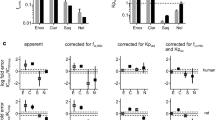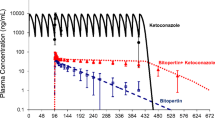ABSTRACT
Purpose
To evaluate 26 marketed oncology drugs for time-dependent inhibition (TDI) of cytochrome P450 (CYP) enzymes. Evaluate TDI-positive drugs for potential to generate reactive intermediates. Assess clinical drug–drug interaction (DDI) risk using static mechanistic models.
Methods
Human liver microsomes and CYP-specific probes were used to assess TDI in a dilution shift assay followed by generation of KI and kinact. Reactive metabolite trapping studies were performed with stable label probes. Static mechanistic model was used to predict DDI risk using a 1.25-fold AUC increase as a cut-off for positive DDI.
Results
Negative TDI across CYPs was observed for 13/26 drugs; the rest were time-dependent inhibitors of, predominantly, CYP3A. The kinact/KI ratios for 11 kinase inhibitors ranged from 0.7 to 42.2 ml/min/μmol. Stable label trapping agent–drug conjugates were observed for ten kinase inhibitors. DDI predictions gave no false negatives, one true negative, four false positives and three true positives. The magnitude of DDI was overestimated irrespective of the inhibitor concentration selected.
Conclusions
13/26 oncology drugs investigated showed TDI potential towards CYP3A, formation of reactive metabolites was also observed. An industry standard static mechanistic model gave no false negative predictions but did not capture the modest clinical DDI potential of kinase inhibitors.








Similar content being viewed by others
Abbreviations
- AUC:
-
area under the curve
- Cav :
-
average plasma concentration
- Cmax :
-
maximum plasma concentration
- CYP:
-
cytochrome P450
- DDI:
-
drug–drug interaction
- HLM:
-
human liver microsomes
- LC:
-
liquid chromatography
- MS/MS:
-
tandem mass spectrometry
- NME:
-
new molecular entity
- PBPK:
-
physiologically based pharmacokinetic modeling
- TDI:
-
time-dependent inhibition
REFERENCES
Riechelmann RP, Del GA. Drug interactions in oncology: how common are they? Ann Oncol. 2009;20(12):1907–12.
Giamas G, Man YL, Hirner H, Bischof J, Kramer K, Khan K, et al. Kinases as targets in the treatment of solid tumors. Cell Signal. 2010;22(7):984–1002.
Sparreboom A, Verweij J. Advances in cancer therapeutics. Clin Pharmacol Ther. 2009;85(2):113–7.
Mani S, Ghalib M, Chaudhary I, Goel S. Alterations of chemotherapeutic pharmacokinetic profiles by drug-drug interactions. Expert Opin Drug Metab Toxicol. 2009;5(2):109–30.
Traer E, Deininger MW. How much and how long: tyrosine kinase inhibitor therapy in chronic myeloid leukemia. Clin Lymphoma Myeloma Leuk. 2010;10 Suppl 1:S20–6.
Banna GL, Collova E, Gebbia V, Lipari H, Giuffrida P, Cavallaro S, et al. Anticancer oral therapy: emerging related issues. Cancer Treat Rev. 2010;36(8):595–605.
Venkatakrishnan K, Pickard MD, von Moltke LL. A quantitative framework and strategies for management and evaluation of metabolic drug-drug interactions in oncology drug development: new molecular entities as object drugs. Clin Pharmacokinet. 2010;49(11):703–27.
Hartmann JT, Haap M, Kopp H-G, Lipp H-P. Tyrosine kinase inhibitors - a review on pharmacology, metabolism and side effects. Curr Drug Metab. 2009;10(5):470–81.
Johnson FM, Agrawal S, Burris H, Rosen L, Dhillon N, Hong D, et al. Phase 1 pharmacokinetic and drug-interaction study of dasatinib in patients with advanced solid tumors. Cancer (Hoboken, NJ, U S). 2010;116(6):1582–91.
Lathia C, Lettieri J, Cihon F, Gallentine M, Radtke M, Sundaresan P. Lack of effect of ketoconazole-mediated CYP3A inhibition on sorafenib clinical pharmacokinetics. Cancer Chemother Pharmacol. 2006;57(5):685–92.
Rakhit A, Pantze MP, Fettner S, Jones HM, Charoin J-E, Riek M, et al. The effects of CYP3A4 inhibition on erlotinib pharmacokinetics: computer-based simulation (SimCYP) predicts in vivo metabolic inhibition. Eur J Clin Pharmacol. 2008;64(1):31–41.
Swaisland HC, Ranson M, Smith RP, Leadbetter J, Laight A, McKillop D, et al. Pharmacokinetic drug interactions of gefitinib with rifampicin, itraconazole and metoprolol. Clin Pharmacokinet. 2005;44(10):1067–81.
van Erp NP, Gelderblom H, Guchelaar H-J. Clinical pharmacokinetics of tyrosine kinase inhibitors. Cancer Treat Rev. 2009;35(8):692–706.
Li X, He Y, Ruiz CH, Koenig M, Cameron MD. Characterization of dasatinib and its structural analogs as CYP3A4 mechanism-based inactivators and the proposed bioactivation pathways. Drug Metab Dispos. 2009;37(6):1242–50.
Li X, Kamenecka TM, Cameron MD. Cytochrome P450-mediated bioactivation of the epidermal growth factor receptor inhibitor erlotinib to a reactive electrophile. Drug Metab Dispos. 2010;38(7):1238–45.
Li X, Kamenecka TM, Cameron MD. Bioactivation of the epidermal growth factor receptor inhibitor Gefitinib: implications for pulmonary and hepatic toxicities. Chem Res Toxicol. 2009;22(10):1736–42.
Teng WC, Oh JW, New LS, Wahlin MD, Nelson SD, Ho HK, et al. Mechanism-based inactivation of cytochrome P450 3A4 by lapatinib. Mol Pharmacol. 2010;78(4):693–703.
Grimm SW, Einolf HJ, Hall SD, He K, Lim H-K, Ling K-HJ, et al. The conduct of in vitro studies to address time-dependent inhibition of drug-metabolizing enzymes: a perspective of the Pharmaceutical Research and Manufacturers of America. Drug Metab Dispos. 2009;37(7):1355–70.
Galetin A, Burt H, Gibbons L, Houston JB. Prediction of time-dependent CYP3A4 drug-drug interactions: impact of enzyme degradation, parallel elimination pathways, and intestinal inhibition. Drug Metab Dispos. 2006;34(1):166–75.
Obach RS, Walsky RL, Venkatakrishnan K. Mechanism-based inactivation of human cytochrome P450 enzymes and the prediction of drug-drug interactions. Drug Metab Dispos. 2007;35(2):246–55.
Rowland YK, Jamei M, Yang J, Tucker GT, Rostami-Hodjegan A. Physiologically based mechanistic modelling to predict complex drug-drug interactions involving simultaneous competitive and time-dependent enzyme inhibition by parent compound and its metabolite in both liver and gut-The effect of diltiazem on the time-course of exposure to triazolam. Eur J Pharm Sci. 2010;39(5):298–309.
Wang Y-H. Confidence assessment of the simcyp time-based approach and a static mathematical model in predicting clinical drug-drug interactions for mechanism-based CYP3A inhibitors. Drug Metab Dispos. 2010;38(7):1094–104.
Zhang X, Quinney SK, Gorski JC, Jones DR, Hall SD. Semiphysiologically based pharmacokinetic models for the inhibition of midazolam clearance by diltiazem and its major metabolite. Drug Metab Dispos. 2009;37(8):1587–97.
Galetin A, Gertz M, Houston JB. Contribution of intestinal cytochrome P450-mediated metabolism to drug-drug inhibition and induction interactions. Drug Metab Pharmacokinet. 2010;25(1):28–47.
Mayhew BS, Jones DR, Hall SD. An in vitro model for predicting in vivo inhibition of cytochrome P450 3A4 by metabolic intermediate complex formation. Drug Metab Dispos. 2000;28(9):1031–7.
Fahmi OA, Maurer TS, Kish M, Cardenas E, Boldt S, Nettleton D. A combined model for predicting CYP3A4 clinical net drug-drug interaction based on CYP3A4 inhibition, inactivation, and induction determined in vitro. Drug Metab Dispos. 2008;36(8):1698–708.
Halladay JS, Delarosa EM, Tran D, Wang L, Wong S, Khojasteh SC. High-throughput, 384-well, LC-MS/MS CYP inhibition assay using automation, cassette-analysis technique and streamlined data analysis. Drug Metab Lett. 2011;5(3):220–30.
Argoti D, Liang L, Conteh A, Chen L, Bershas D, Yu C-P, et al. Cyanide trapping of iminium ion reactive intermediates followed by detection and structure identification using liquid chromatography-tandem mass spectrometry (LC-MS/MS). Chem Res Toxicol. 2005;18(10):1537–44.
Yan Z, Maher N, Torres R, Caldwell GW, Huebert N. Rapid detection and characterization of minor reactive metabolites using stable-isotope trapping in combination with tandem mass spectrometry. Rapid Commun Mass Spectrom. 2005;19(22):3322–30.
Gertz M, Harrison A, Houston JB, Galetin A. Prediction of human intestinal first-pass metabolism of 25 CYP3A substrates from in vitro clearance and permeability data. Drug Metab Dispos. 2010;38(7):1147–58.
Houston JB, Galetin A. Methods for predicting in vivo pharmacokinetics using data from in vitro assays. Curr Drug Metab. 2008;9(9):940–51.
Neuvonen PJ, Kantola T, Kivisto KT. Simvastatin but not pravastatin is very susceptible to interaction with the CYP3A4 inhibitor itraconazole. Clin Pharmacol Ther. 1998;63(3):332–41.
Kovarik JM, Beyer D, Bizot MN, Jiang Q, Shenouda M, Schmouder RL. Blood concentrations of everolimus are markedly increased by ketoconazole. J Clin Pharmacol. 2005;45(5):514–8.
Gertz M, Harrison A, Houston JB, Galetin A. Prediction of human intestinal first-pass metabolism of 25 CYP3A substrates from in vitro clearance and permeability data. Drug Metab Dispos. 2010;38(7):1147–58.
Yang J, Liao M, Shou M, Jamei M, Yeo KR, Tucker GT, et al. Cytochrome P450 turnover: regulation of synthesis and degradation, methods for determining rates, and implications for the prediction of drug interactions. Curr Drug Metab. 2008;9(5):384–93.
Yang J, Jamei M, Yeo KR, Tucker GT, Rostami-Hodjegan A. Prediction of intestinal first-pass drug metabolism. Curr Drug Metab. 2007;8(7):676–84.
Duckett DR, Cameron MD. Metabolism considerations for kinase inhibitors in cancer treatment. Expert Opin Drug Metab Toxicol. 2010;6(10):1175–93.
Guest EJ, Aarons L, Houston JB, Rostami-Hodjegan A, Galetin A. Critique of the two-fold measure of prediction success for ratios: application for the assessment of drug-drug interactions. Drug Metab Dispos. 2011;39(2):170–3.
Ozaki S, Minamisono T, Yamashita T, Kato T, Kushida I. Supersaturation-nucleation behavior of poorly soluble drugs and its impact on the oral absorption of drugs in thermodynamically high-energy forms. J Pharm Sci. 2011;No pp. yet given.
Burt HJ, Galetin A, Houston JB. IC50-based approaches as an alternative method for assessment of time-dependent inhibition of CYP3A4. Xenobiotica. 2010;40(5):331–43.
Galetin A, Clarke SE, Houston JB. Multisite kinetic analysis of interactions between prototypical CYP3A4 subgroup substrates: midazolam, testosterone, and nifedipine. Drug Metab Dispos. 2003;31(9):1108–16.
Wang YH, Jones DR, Hall SD. Prediction of cytochrome P450 3A inhibition by verapamil enantiomers and their metabolites. Drug Metab Dispos. 2004;32(2):259–66.
Rendic S. Summary of information on human CYP enzymes: Human P450 metabolism data. Drug Metab Rev. 2002;34(1 & 2):83–448.
Yeung CK, Fujioka Y, Hachad H, Levy RH, Isoherranen N. Are circulating metabolites important in drug-drug Interactions?: quantitative analysis of risk prediction and inhibitory potency. Clin Pharmacol Ther (N Y, NY, U S). 2010;89(1):105–13.
Lin YS, Dowling ALS, Quigley SD, Farin FM, Zhang J, Lamba J, et al. Co-regulation of CYP3a4 and CYP3a5 and contribution to hepatic and intestinal midazolam metabolism. Mol Pharmacol. 2002;62(1):162–72.
Xie H-G, Wood AJJ, Kim RB, Stein CM, Wilkinson GR. Genetic variability in CYP3A5 and its possible consequences. Pharmacogenomics. 2004;5(3):243–72.
Hutzler JM, Tracy TS. Atypical kinetic profiles in drug metabolism reactions. Drug Metab Dispos. 2002;30(4):355–62.
Li J, Zhao M, He P, Hidalgo M, Baker SD. Differential metabolism of gefitinib and erlotinib by human cytochrome P450 enzymes. Clin Cancer Res. 2007;13(12):3731–7.
Sugiyama M, Fujita K-I, Murayama N, Akiyama Y, Yamazaki H, Sasaki Y. Sorafenib and sunitinib, two anticancer drugs, inhibit CYP3A4-mediated and activate CY3A5-mediated midazolam 1′-hydroxylation. Drug Metab Dispos. 2011;39(5):757–62.
Henshall J, Galetin A, Harrison A, Houston JB. Comparative analysis of CYP3A heteroactivation by steroid hormones and flavonoids in different in vitro systems and potential in vivo implications. Drug Metab Dispos. 2008;36(7):1332–40.
McConn II DJ, Lin YS, Allen K, Kunze KL, Thummel KE. Differences in the inhibition of cytochromes P450 3A4 and 3A5 by metabolite-inhibitor complex-forming drugs. Drug Metab Dispos. 2004;32(10):1083–91.
Evans DC, Watt AP, Nicoll-Griffith DA, Baillie TA. Drug-protein adducts: an industry perspective on minimizing the potential for drug bioactivation in drug discovery and development. [Erratum to document cited in CA140:138559]. Chem Res Toxicol. 2005;18(11):1777.
Goldszer F, Tindell GL, Walle UK, Walle T. Chemical trapping of labile aldehyde intermediates in the metabolism of propranolol and oxprenolol. Res Commun Chem Pathol Pharmacol. 1981;34(2):193–205.
Takakusa H, Wahlin MD, Zhao C, Hanson KL, New LS, Chan ECY, et al. Metabolic intermediate complex formation of human cytochrome P450 3A4 by lapatinib. Drug Metab Dispos. 2011;39(6):1022–30.
Riley RJ, Grime K, Weaver R. Time-dependent CYP inhibition. Expert Opin Drug Metab Toxicol. 2007;3(1):51–66.
Park BK, Boobis A, Clarke S, Goldring CEP, Jones D, Kenna JG, et al. Managing the challenge of chemically reactive metabolites in drug development. Nat Rev Drug Discovery. 2011;10(4):292–306.
ACKNOWLEDGMENTS & DISCLOSURES
We thank Dr Cornelis ECA Hop for encouragement to investigate these oncology drugs and members of Genentech DMPK for valuable discussions.
Author information
Authors and Affiliations
Corresponding author
Additional information
This work was presented in part at the PSW AAPS meeting, 2010, New Orleans.
Electronic supplementary material
Below is the link to the electronic supplementary material.
ESM 1
(DOC 66 kb)
Rights and permissions
About this article
Cite this article
Kenny, J.R., Mukadam, S., Zhang, C. et al. Drug–Drug Interaction Potential of Marketed Oncology Drugs: In Vitro Assessment of Time-Dependent Cytochrome P450 Inhibition, Reactive Metabolite Formation and Drug–Drug Interaction Prediction. Pharm Res 29, 1960–1976 (2012). https://doi.org/10.1007/s11095-012-0724-6
Received:
Accepted:
Published:
Issue Date:
DOI: https://doi.org/10.1007/s11095-012-0724-6




